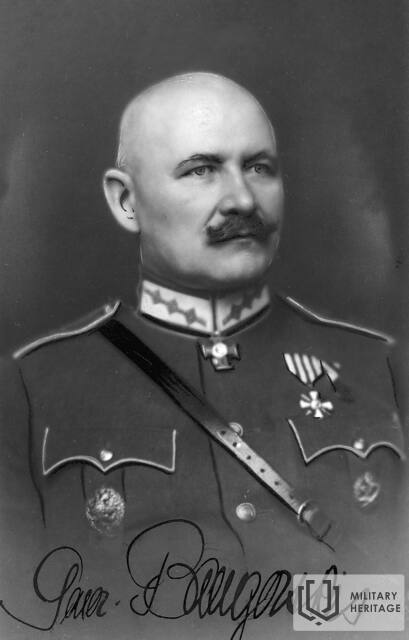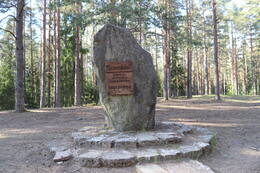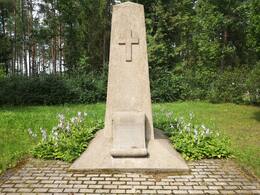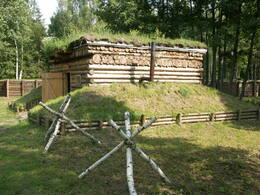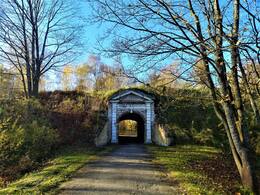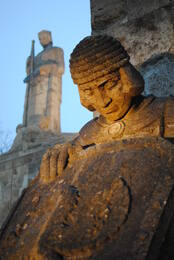General Rudolf Bangersky
I WW1, I Wars of Independence, Independence of the Baltic States, II WW2
Rūdolfs Bangerskis was born on July 21, 1878 in Līčakrogs, Taurupe Parish. Studied at Zaube Primary School and Jaunjelgava City School. In 1895 he joined the army, serving in both Riga and St. Petersburg.
In 1914, with the outbreak of World War I, R. Bangerski returned to the 36th Infantry Regiment as commander of the company and already in December 1914 received the rank of captain. After the formation of the Latvian Rifle Battalion in August 1915, R. Bangerski was appointed Commander of the 1st Daugavgrīva Latvian Rifle Battalion. In October 1916, Mr Bangerski was promoted to lieutenant colonel and two months later to colonel.
In December 1916, R. Bangerskis became the commander of the position of the commander of the 2nd Riga Latvian Rifle Regiment, but during the Christmas battles - the head of the headquarters of the joint Latvian Rifle Division. g. Jan 17 in the battle near Ložmetējkalns, Bangerskis personally carried out reconnaissance and clarified the position of the front, led a regiment in a dagger battle under direct and fierce shooting, thus greatly facilitating the recapture of enemy positions ”. For these merits in 1923 R. Bangerski was awarded the 3rd class Latvian Lāčplēsis War Order No. 1627
In February 1924, R. Bangerski enlisted in the Latvian Army as a colonel, and from December 1924 to December 1925, and from December 1926 to January 1928, R. Bangerski was Minister of War.
Minister of War J. Balodis praises R. Bangerski in an article in the newspaper “Rīts” No. 76 (March 17, 1937) “Honoring General R. Bangerski”: “He has been one of the most outstanding creators and leaders of Latvian rifle regiments in famous battles. His rich fighting adventures and experiences, his unbreakable energy, and the great hospitality and care for his subjects have blessed and facilitated the formation of our entire army. ”
During World War II, during the German occupation from 1942 to 1943, R. Bangerskis was the rapporteur of the General Directorate of Justice of the local government, later also the inspector general of the Latvian Legion and the SS group leader. On February 20, 1945, in Potsdam, Germany, R. Bangerski was elected Chairman of the Latvian National Committee. From June 1945 to December 1946, Mr Bangerski was held in British custody. After his release he lived in Oldenburg, Germany. Died February 25, 1958. On March 16, 1995, he was reburied in the Brothers' Cemetery in Riga.
During his military career, R. Bangerski received the Latvian Order of the 3rd Class Lāčplēsis War Order, the 2nd Class Order of the Three Stars, the Order of Merit of the Latvian Defenders, the Order of the French Legion of Honor, the Estonian Freedom Cross, the 1st Class Order of the Twisted Cross of Lithuania, the Russian Order . Jurassic sword, as well as other high awards of Latvia, Estonia, Lithuania, Poland, Russia and Germany.
More information sources
Source: Latvian War Museum. General Rudolf Bangersky (1878–1958). Available: http://www.karamuzejs.lv/lv/Izstades/generali/generalis_BangerskisRudolfs.aspx [accessed 21.10.2021]
Related objects
Ložmetējkalns (Machine Gun Hill) in Tīreļpurvs Bog
Ložmetējkalns is located in Valgunde Rural Territory, Jelgava Municipality, close to the A9 motorway. It is the site of a World War I battle and the only cultural heritage conservation site of national importance in Latvia. Ložmetējkalns is located on Garā Kāpa Dune, which is a part of the Nordeķi-Kalnciems dune ridge. The name originated at a time when it was the site of impregnable fortifications of the German Army, which was defended by heavy machine-gun fire. The Christmas Battles are one of the best-known and most dramatic events of World War I in the history of Latvia. In 1917, the units of Latvian Riflemen and Siberian riflemen of the Russian Army attacked and took Ložmetējkalns, capturing at least 600 enemy troops and valuable trophies. The riflemen believed that they were the ones who deserved the honour of captors of the highlands. The area around Ložmetējkalns Hill is home to commemora tive marks and other evidence of the battles that took place here. Every year, in January, memorial events are held in the surroundings of Ložmetējkalns to remember the Christmas Battles. Nowadays, Ložmetējkalns has become a symbol and a memorial site dedicated to the heroism of Latvian Riflemen. A 27-metre-high observation tower offers panoramic views of the site of Christmas Battles.
Christmas battles memorial at Antinu Brethren Cemetery
Located in Babīte district, on the side of the road near the former Antiņi house and the old medicine warehouse.
The cemetery of Antiņi or Tīreļi soldiers was established during the First World War. The defense positions of the army of the Russian Empire were located in the area. In 1917, during the Christmas battles, the headquarters of the 5th Zemgale Latvian Rifle Regiment and an infirmary with a medicine warehouse were located nearby.
In the night of January 5, 1917, in the light of eight huge bonfires, 105 fighters of the 5th Zemgale Latvian Rifle Regiment were buried in military honor. They fell in battle against the German army or died from injuries. The funeral ceremony was led by Regiment Commander Jukums Vācietis. In later years, soldiers from other units of the Russian army were also buried in the cemetery. In 1925, a monument to the architect Eizen Laube was unveiled in the cemetery, and the territory was landscaped. Information about the 3,800 soldiers buried in the cemetery can be found in many places, but it must be assessed as unlikely and unverified.
Christmas Battle Museum
The museum is located in “Mangali” house, Valgunde Ru ral Territory, Jelgava Municipality, and it is a branch of the Latvian War Museum. It was unveiled in 2005 at the site of the Christmas Battles that occurred during World War I. Unique World War I fortifications still remain at the battle sites. The open-air exhibition of the Christmas Battle Mu seum reconstructs a section of the fortification system – the trench shelter and part of the first line of German defence – the “German rampart”, which is the only object of this kind in the Baltic states. The Christmas Battles are one of the best known and most dramatic events of World War I in Latvia. They are an event of special importance in Latvian military and cultural his tory. Intense fighting took place for six days, leading to heavy casualties. The battles are mainly associated with the attack of Latvian Riflemen against the German Army units, which took place in particularly severe and unfa vourable winter conditions. This is an unprecedented case of a major combat operation launched without artillery support. Today, the museum artefacts found at the sites of the bat tle are on display. The indoor exhibition is open at certain times, while the exhibition of outdoor fortifications is open every day. Tourist routes and nature trails have been cre ated in the surrounding area.
Daugavgrīva Fortress
Daugavgrīva Fortress (entry from Birzes street) is located on the Daugavgrīva Island where Buļļupe river joins the Daugava river. The fortress was built in the 17th century to defend from enemies moving in the direction of Riga, which was an important administrative, trade and production centre. Later it became the main fortification of the Latvian Army coastal defence with several support points. This defensive fortification system is one of the most valuable objects of Latvia's military heritage. This fortress has witnessed Latvian military history. For example, during the Crimean War (1853-1856) Latvian and Estonian gunboat crews were trained here. The main objective of these units was to protect local ports and the coast from attacks by the British navy. During World War I Daugavgrīva militiamen companies were formed here. These were the first Latvian combat units, which came even before the Latvian Riflemen. Nowadays it is possible to see the territory of the fortress. ‘Komētforts’ and the Seaside Nature Park are located nearby and Mangaļsala fortifications are on the other side of the Daugava river.
Brothers' Cemetery in Riga
Riga Brothers’ Cemetery is located in the northern district of Riga. The cemetery extends over an area of 9 ha and is the most outstanding and significant memorial ensemble in Latvia dedicated to the fallen Latvian soldiers. About 3,000 soldiers are buried here. The Brothers’ Cemetery was created during World War I after the first three Latvian Riflemen, who fell in Tīreļpurvs in the battle against the German Army, were buried here. Later Latvian soldiers who had died in other battles and wars would also be buried in the Brothers’ Cemetery. The memorial is based on the design of the sculptor Kārlis Zāle, and is the first memorial ensemble in Europe with such landscape, architecture and sculptural value. It uses elements typical to the Latvian landscape, traditional farmsteads, Latvian folklore and history that praise the characteristics of soldiers and tell the story of the way of the soldier. The memorial was unveiled in 1936 and it has three parts: ‘The Road of Though’ which is a 250 m long alley, ‘Terrace of Heroes’ with the Altar of the Sacred Flame and ensemble the Sacred Oak Grove, and the burial ground with the Latvian wall and a memorial of a mother with her fallen sons.
Related stories
About Christmas battles
The Christmas battle ended on January 11. The Latvian riflemen of the heavily fortified position of the German army - Ložmetējkalns - managed to take the battle on the third day. The price of Christmas battles was very high. Hundreds of Latvian and other Russian army soldiers had lost their lives trying to knock the Germans out of position. The narrator vividly describes the scenes on the battlefield after the end of the Christmas battles.
About Daugavgriva fortress
The narrator describes an event in the Daugavgrīva fortress during World War I, when it was bombed by an air force in the German army. The fortress was one of the strategic objects that remained important until the end of World War II.




